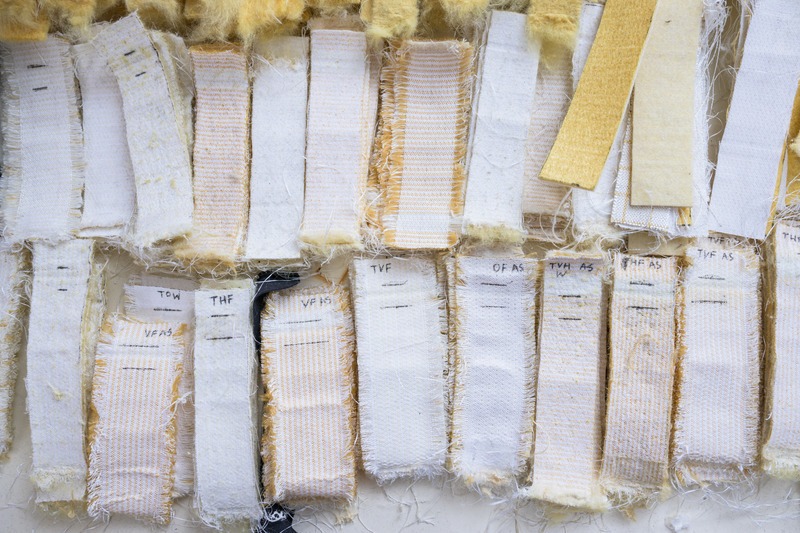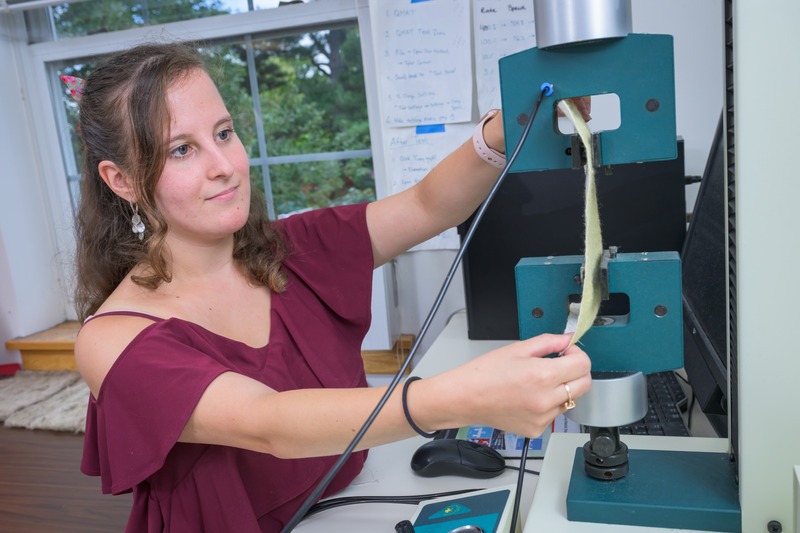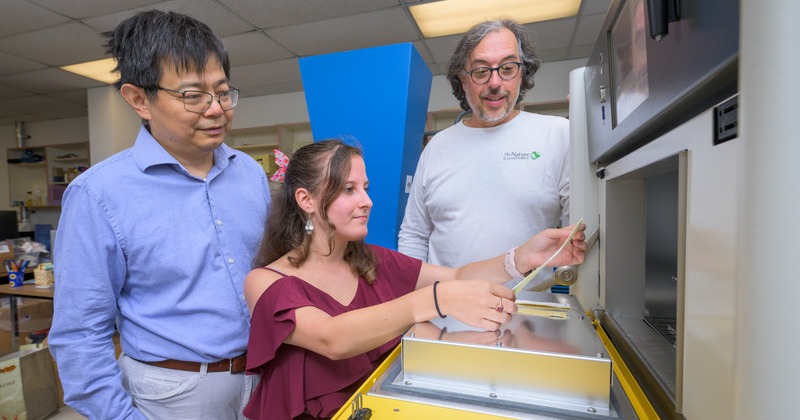Interdisciplinary collaboration leads to innovative new fabric
When future astronauts head to the Moon, they may very well be wearing space suits created, in part, through a collaboration between two University of Delaware academic departments, a new UD alumnae and a company founded by UD alumni.
This interdisciplinary project included Norm Wagner, the Unidel Robert L. Pigford Chair, Chemical and Biomolecular Engineering; Huantian Cao, chair of the Department of Fashion and Apparel Studies; Richard Dombrowski, former associate research scientist in UD’s Department of Chemical Engineering and co-founder of STF Technologies, and Michelle Yatvitskiy, who graduated this year with a master’s degree in fashion and apparel studies and a graduate certificate in sustainable apparel business.
The outcome of their collaboration is a new fabric for the outer layer of space suits, called the environmental protection garment (EPG) shell, that will prevent lunar dust particles from penetrating the material.
“Our fashion apparel studies program covers everything related to clothing, and space suits are a form of clothing,” said Cao. “Quite a few of our alumni work with ILC Dover, a major space suit manufacturer.”
One may not immediately think of outer layers of clothing as having the potential to create a collaboration between chemical engineers and fashion designers, however, “clothing provides the ultimate level of protection, and that requires science and engineering too,” he said.
For lunar astronauts, the critical problem lies with the dust and soil on the moon’s surface called regolith. The regolith particles are fine and very sharp, like volcanic rocks and dust here on Earth. As the current EPG material is woven, the particles infiltrate the fabric through the tiny holes in the weave, damaging it.
“The Apollo astronauts spent only a few hours on the surface and their suits were basically destroyed,” Wagner said.
On top of that, regolith dust is dangerous to inhale, and Martian regolith contains toxic perchlorates.
“It’s not just an annoyance, it’s not just a problem from the dust getting into everything and destroying stuff. It’s also potentially emitting gasses, so we really have to keep it off the suits. The fabric has to reject the particles,” Wagner said.

The new fabric upgrades the previous EPG shell material by including shear thickening fluid and felting to make it strong and dust-resistant.
In the beginning
The partnership began in 2022 when Wagner and Dombroski and their company STF Technologies received a grant from NASA to explore making an improved EPG shell. The pair had an idea for a hybrid woven/non-woven fabric but knew they couldn’t make it happen alone.
“There’s a lot more textile engineering and science built into meeting the challenges that NASA has for their astronauts now, for working and living on the surface of the moon and then ultimately Mars,” Wagner said. “We could do some things, but we needed real textile experts to do this.”
They partnered with Cao and Yatvitskiy to make their vision a reality. After a few trials, the team created a new material that takes the EPG shell’s original Vectran™ Orthofabric and embeds shear thickening fluid, a material co-developed by UD and STF Technologies that has been used in other projects related to space suits, into and between the fibers. Fire-retardant and dust-resistant P84® fibers are felted onto the back. The combination gives the material strength and keeps out the dust.
“Originally, we were going to do a non-woven fabric, but that’s not strong enough,” said Yatvitskiy. So we took the original EPG shell fabric and basically plugged the holes by felting on top of it, another word for needle punching.
“We used a felt loom in Alison West that we had been using for a recycled textile project,” she explained. “When you run the fibers through the machine, hundreds of needles puncture the fabric, interlocking the fibers to create, in this case, a new stronger textile.”
Yatvitskiy tested the fabric for tensile strength using a machine that stretches it between two clamps, pulling it until it rips. She also ran a sun test where the fabric was placed in a machine that simulated the sun’s rays for two weeks. Further tests were done at STF Technologies. The new shell passed all of the tests with flying colors.
In her opinion, the next step in the testing process is to send fabric swatches into space as part of an International Space Station mission. “We would do the same testing on the fabric after it has been exposed to the actual elements since you can’t simulate everything in the lab,” she added.

Samples of various fabrics that were created during the project.
Designing opportunities
Yatvitskiy got her start with the project through an internship with the Delaware Space Grant Consortium (DESGC) in which she did testing to get base numbers on the original EPG shell. She also received a graduate student fellowship from DESGC to work on this project. She was involved with all of the presentations and calls the team had with NASA throughout the process.
The Brooklyn, New York, native who received her undergraduate degrees in apparel design and fashion merchandising from UD in 2022, said the work combined her love of “mixing math and science” with design, an opportunity that is the hallmark of the fashion program.
“When I visited UD, they were talking about mushroom shoe research, creating soles of shoes from mushrooms, which I found fascinating,” she said. “It was the perfect school for me because of its research program.”
Cao said the department is working with more than half of UD’s colleges on projects that range from developing sustainable weed control mulch mats to functional fashion for people with disabilities.
“We want to find and fund the opportunities for our students to gain knowledge and get firsthand experience. For students to be competitive in their careers—this type of career—we need to provide opportunities for collaboration with other disciplines,” he said.
The team has applied to NASA for the next phase of funding which would allow them to further develop the product. In the meantime, STF Technologies is using this research to work on other ideas, such as gear for firefighters, as the material is flame retardant and prevents soot and other contaminants from getting into suits.
“This is the new science,” Wagner said. “The new technologies most often come at the interfaces between disciplines.”

Michelle Yatvitskiy inserts the fabric sample into a machine to test its tensile strength. The machine pulls the fabric in different directions until it rips.
Article by Brenda Lange and Hilary Douwes | Photos by Evan Krape (featured on UDaily, 10/01/2024)

